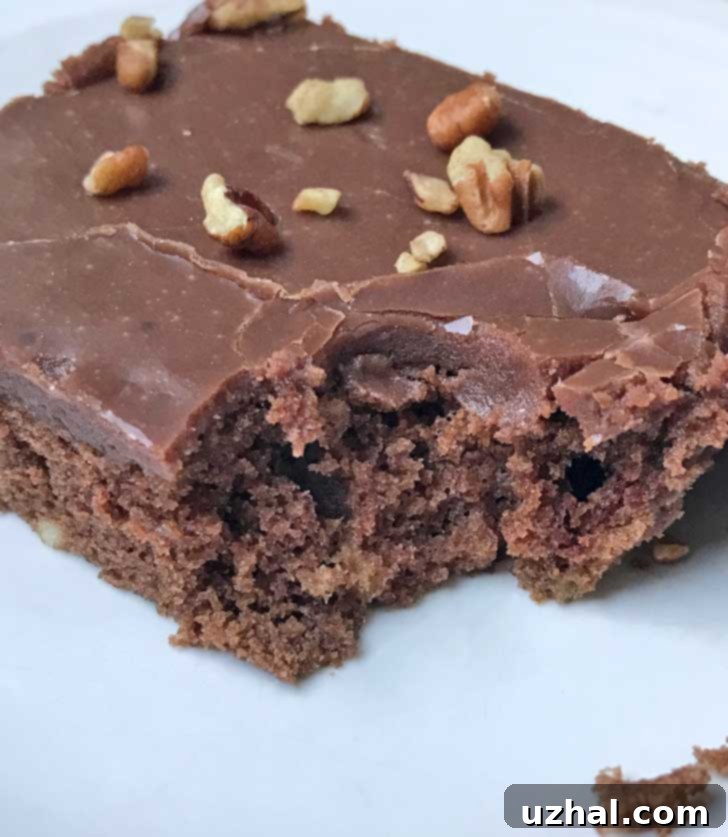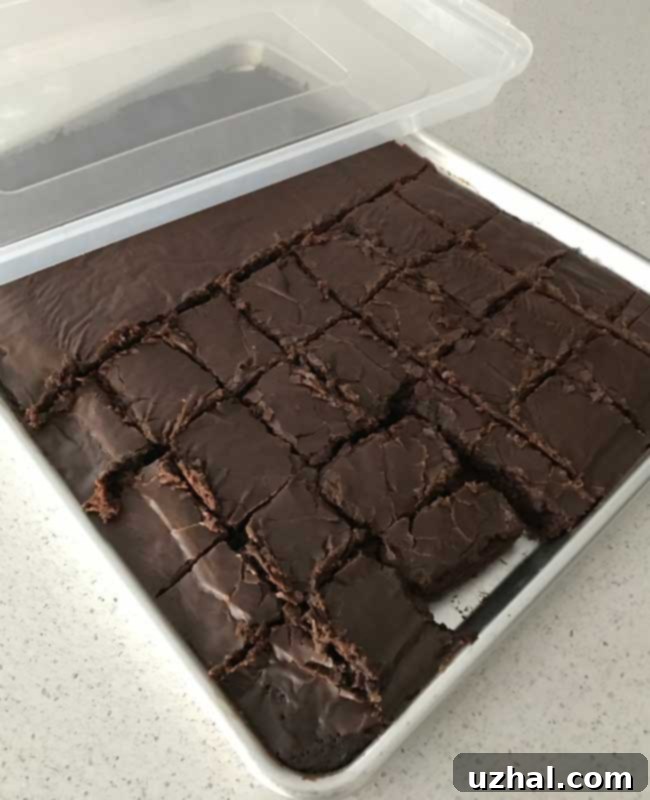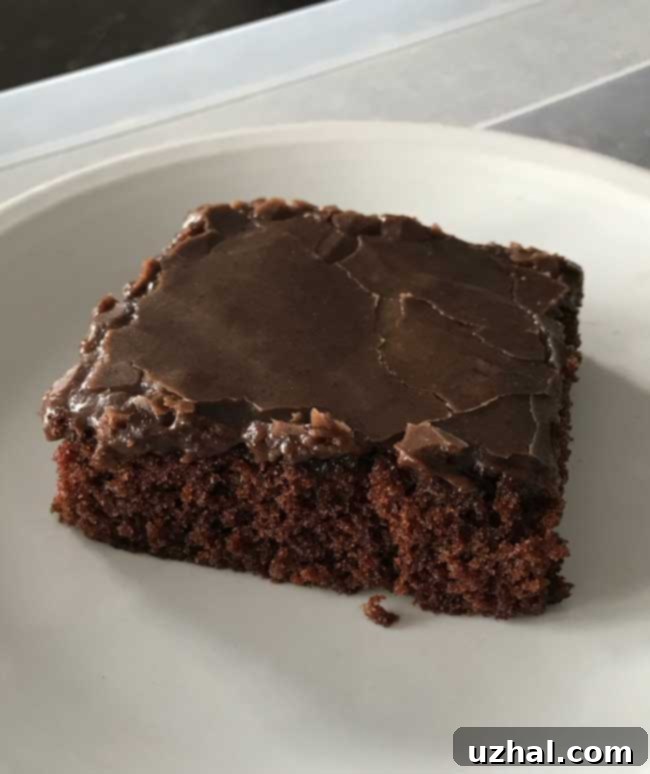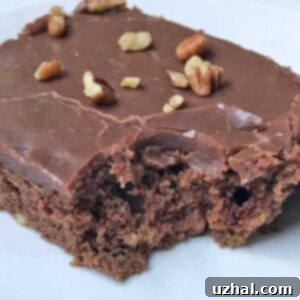The Ultimate Guide to Baking the Perfect Texas Sheet Cake: A Beloved Southern Dessert
The Texas Sheet Cake holds a special place in the hearts of Texans and dessert lovers far beyond the Lone Star State, and for very good reason. This iconic dessert isn’t just a cake; it’s a testament to Southern hospitality and a staple at gatherings, potlucks, and family celebrations. Its widespread appeal stems from a perfect trifecta: it’s incredibly easy to make with relatively inexpensive ingredients, doesn’t demand a fancy electric mixer, and can go from mixing bowl to serving pan in under an hour. But what truly sets it apart, like many cherished Southern desserts, is its decadent richness and profound sweetness. The melt-in-your-mouth chocolate cake is perfectly complemented by a luscious, pour-on icing – a highlight that many, myself included, consider the very best part.

The Authentic Experience: Embracing the Half Sheet Pan Size
One of the defining characteristics of an authentic Texas Sheet Cake is its thin profile. This isn’t your towering layer cake; it’s designed to be spread generously across a large pan, yielding a moist, tender crumb that’s just thick enough to provide a satisfying bite. While it’s common for home bakers to adapt recipes to smaller 9×13 inch cake pans, and there’s certainly no culinary crime in doing so, using a traditional half sheet pan truly honors the cake’s original purpose and delivers the intended texture. A standard half sheet pan typically measures around 18×13 inches (or 17×12 inches, like the Nordicware pan mentioned), creating that wonderfully thin dessert perfect for serving a crowd.
The historical context behind this thinness is rooted in practicality. Texas Sheet Cake originated as a potluck dessert, intended to satisfy a large number of people who had likely already enjoyed a full meal. A thin slice, bursting with chocolate flavor, provides that perfect “few bites of something sweet” without being overly heavy. It’s also incredibly easy to transport and serve directly from the pan, simplifying the process for hosts and guests alike. For those seeking authenticity and convenience, I highly recommend a sturdy half sheet pan. My personal favorite is the Nordicware Lidded Half Sheet Pan, which not only bakes beautifully but also comes with a lid, making transport and storage an absolute breeze.

As a proud Texan, you might expect me to be constantly whipping up batches of this magnificent cake, but the truth is, its generous size makes it a dessert reserved for larger gatherings. Our family, like many, often finds it too much for just a few people. And even when there’s a big event on the horizon, chances are a beloved relative will already be bringing their famous version! This means that when I do get to bake it, I sometimes venture into making small batch Texas Sheet Cake variations, adapting the recipe to a smaller pan for more manageable portions. However, for the full, unadulterated experience, nothing beats the classic large sheet cake.

What Makes This Texas Sheet Cake Recipe Stand Out
While many Texas Sheet Cake recipes share core similarities, subtle variations can make a significant difference. This particular recipe distinguishes itself with two key ingredients that elevate its flavor profile: brown sugar in the cake batter and sour cream in the frosting. Traditionally, many recipes call for two cups of granulated sugar. While that version is undoubtedly delicious and can sometimes yield a slightly “clearer” chocolate flavor, the inclusion of brown sugar in this recipe adds a remarkable depth. Brown sugar introduces molasses notes, creating a richer, moister cake with a more complex, almost caramel-like undertone that beautifully complements the chocolate. It makes the cake not just sweet, but truly memorable.
The other star ingredient that truly sets this cake apart is the sour cream in the pour-on frosting. Unlike a standard buttercream, the sour cream in the icing serves a crucial purpose: it subtly cuts through the intense sweetness. This slight tang from the sour cream creates a perfect balance, preventing the cake from being cloyingly sweet and instead offering a more sophisticated, well-rounded flavor. It also contributes to the frosting’s signature silky, pourable consistency, allowing it to effortlessly blanket the warm cake, creating a thin, glossy layer that sets to a soft, fudge-like texture. This combination of brown sugar in the cake and sour cream in the icing creates a truly exceptional Texas Sheet Cake that stands out from the crowd.
Expert Tips for Your Best Texas Sheet Cake
Achieving a fantastic Texas Sheet Cake is well within reach, especially when you keep a few crucial tips in mind. This recipe delivers a wonderfully thin cake with a delicious pour-on sour cream icing, staying true to its classic form. These are some of the most important insights I can share to ensure your baking success:
- Opt for Natural Cocoa Powder (Preferably Hershey’s): When making the cake, always choose natural cocoa powder over Dutch-processed. Natural cocoa is acidic and reacts with the baking soda in the recipe to provide leavening, contributing to the cake’s tender texture. Dutch-processed cocoa, on the other hand, has been alkalized, neutralizing its acidity, and therefore won’t react as effectively with baking soda. Natural cocoa also tends to have a brighter, more pronounced chocolate flavor, which is exactly what you want in a rich chocolate cake. Hershey’s natural unsweetened cocoa is a widely available and reliable choice.
- A Whisper of Cinnamon: Don’t skip the cinnamon! Adding a tiny amount – just ⅛ to ¼ teaspoon – might seem insignificant, but it works wonders. Cinnamon doesn’t make the cake taste like a spice cake; instead, it subtly enhances and deepens the chocolate flavor, adding a layer of warmth and complexity that truly elevates the overall taste without being detectable on its own. It’s the secret ingredient that makes people wonder why your cake tastes so good.
- Sift Your Confectioners’ Sugar: This tip is paramount for the frosting. Confectioners’ sugar (powdered sugar) often contains small lumps from packing. Sifting it before you mix your icing is essential to achieve a perfectly smooth, pourable frosting without any gritty bits. If you prefer to measure by weight, you’ll still want to sift it for optimal results.
- Embrace Sour Cream in the Icing: As mentioned, sour cream is a game-changer for this frosting. Its slight tanginess provides a wonderful contrast to the sweetness, creating a more balanced and nuanced flavor profile. It also contributes to the icing’s luxurious, creamy texture, allowing it to spread beautifully over the warm cake and set to a smooth finish. Ensure your sour cream is at room temperature for the best blending results.
- Serve the Cake Right Out of the Pan: For true Texas authenticity and ultimate convenience, serve the cake directly from the pan. This is a no-fuss dessert designed for communal enjoyment. There’s no need to worry about transferring it to a serving platter; simply slice and serve from the half sheet pan. It emphasizes the rustic, homey charm of this beloved dessert.
- Pair with Blue Bell Homemade Vanilla (Gold Rim): If you want the quintessential Texas Sheet Cake experience, serve it alongside a scoop of Blue Bell Homemade Vanilla ice cream, specifically the “Gold Rim” version. Blue Bell is a Texas institution, and its rich, creamy, perfectly sweet vanilla ice cream is the absolute ideal accompaniment to the warm, chocolatey cake. The cold ice cream provides a delightful temperature and textural contrast that makes each bite heavenly.
A Brief History and Enduring Popularity
While the exact origins of the Texas Sheet Cake are somewhat debated, it’s widely believed to have emerged from Texas in the mid-20th century. Its popularity soared due to its practical nature for feeding large crowds, making it a favorite for church potlucks, family reunions, and school functions. The simplicity of its preparation—often involving melting butter and cocoa on the stovetop and mixing in other ingredients—made it accessible even to novice bakers. The “sheet cake” designation itself refers to its baking method in a large, shallow pan, which also allowed for the signature pour-over frosting that sets quickly. This humble yet magnificent dessert quickly became a symbol of hearty Southern cooking and generous hospitality, embodying the spirit of sharing good food with good company.
Serving and Storage Suggestions
Beyond the classic Blue Bell pairing, Texas Sheet Cake is versatile. It’s wonderful with a tall glass of cold milk, a dollop of fresh whipped cream, or a warm cup of coffee. The cake is typically served at room temperature, making it perfect for events where refrigeration space is limited. To store leftovers, simply cover the sheet pan tightly with its lid or aluminum foil. It will stay fresh and moist at room temperature for up to 3-4 days. For longer storage, you can freeze slices wrapped individually in plastic wrap and then placed in an airtight container for up to 2-3 months. Thaw at room temperature for a few hours before serving.
Explore More Southern-Inspired Treats
If you love the generous spirit and delicious flavors of Texas Sheet Cake, you might enjoy exploring other Southern-inspired recipes designed to delight a crowd. From oversized cookies to unique twists on classic desserts, there’s a whole world of comfort baking to discover.
- Texas Size Peanut Butter Cookies
- Small White Texas Sheet Cake
- Jumbo Chocolate Banana Muffins
- Texas Chocolate Pecan Pie Bars
Recipe

Texas Sheet Cake
Anna
Pin Recipe
20 minutes
15 minutes
35 minutes
Dessert
American
32
Ingredients
-
2
cups
all-purpose flour
(270 grams) -
1
scant cup
granulated sugar
(185 grams) -
1
teaspoon
salt, scant -
⅛ to ¼
teaspoon
cinnamon
optional -
2
sticks
unsalted butter
(230 grams) -
1
cup
light brown sugar, packed
(200 grams) -
⅓
cup
unsweetened natural (not Dutch) cocoa powder -
1
cup
water -
2
large
eggs -
1
teaspoon
vanilla -
½
cup
buttermilk -
1
teaspoon
baking soda
Frosting:
-
2 ¾
cups
confectioners’ sugar, measure by weight if possible
(390 grams) sifted -
1
stick
unsalted butter
(114 grams) -
¼
teaspoon
salt — omit if using salted butter -
4
tablespoons
unsweetened natural cocoa powder
(20 grams) -
⅓
cup
full fat sour cream
room temperature -
1
teaspoon
vanilla extract
Instructions
-
Preheat oven to 375 degrees F (190 C). Grease the bottom only of a 12×17 inch sheet pan with salted butter or margarine.
-
In a large mixing bowl, thoroughly whisk together the all-purpose flour, granulated sugar, salt, and cinnamon (if using) until well combined.
-
In a 3 ½ quart saucepan, melt the two sticks of unsalted butter over medium heat. Stir in the light brown sugar, unsweetened natural cocoa powder, and water. Bring this mixture to a rolling boil, then immediately remove from heat. Carefully pour the hot cocoa mixture into the large mixing bowl containing the flour mixture and stir by hand with a whisk or spoon until completely blended and smooth.
-
Using the same saucepan (no need to wash it), stir together the eggs, vanilla extract, and buttermilk. Add this egg mixture along with the baking soda to the chocolate batter. Stir everything by hand until just blended. Do not overmix.
-
Pour the very liquid batter evenly into the prepared sheet pan. Bake for approximately 15 minutes. The cake is done when it springs back lightly when gently touched in the center and an inserted toothpick comes out with moist crumbs. An internal temperature of about 200 degrees F is also a good indicator. It will be pretty obvious when it’s ready.
-
While the cake is baking, prepare your frosting ingredients. Weigh out your confectioners’ sugar and sift it thoroughly into a bowl to ensure there are no lumps. Set it aside.
-
Clean out the saucepan used for the cake batter mixture. Melt the one stick of unsalted butter over medium heat. Add the salt (if using unsalted butter) and the unsweetened natural cocoa powder. Stir constantly until the mixture is smooth. Remove the saucepan from the heat and immediately stir in the room temperature full-fat sour cream. Add the vanilla extract, then gradually add the sifted confectioners’ sugar, about 1 cup at a time, stirring vigorously until the frosting is smooth and well combined. If the icing starts to thicken too much, you can place it back on very low heat, but the residual heat from the butter/cocoa mixture should generally be sufficient to keep it pourable. Immediately pour the warm frosting over the warm, freshly baked cake, tilting the pan gently to ensure it covers the cake evenly from edge to edge. Let the cake and frosting set for a bit before slicing and serving.
Texas Sheet Cake
Tried this recipe?
Let us know how it was!
Conclusion: A Timeless Taste of Texas
The Texas Sheet Cake is more than just a dessert; it’s a culinary tradition that embodies warmth, generosity, and the rich flavors of Southern baking. Its ease of preparation, affordability, and ability to feed a crowd make it a cherished recipe for countless families and a beloved staple at any gathering. With its distinct thin profile, rich chocolate cake enhanced by brown sugar, and the perfectly balanced tang of sour cream frosting, this cake offers a delightful experience that leaves a lasting impression. Whether you’re a seasoned baker or just starting, following these tips and the detailed recipe will ensure you create a perfect Texas Sheet Cake every time – a true slice of Southern comfort.
